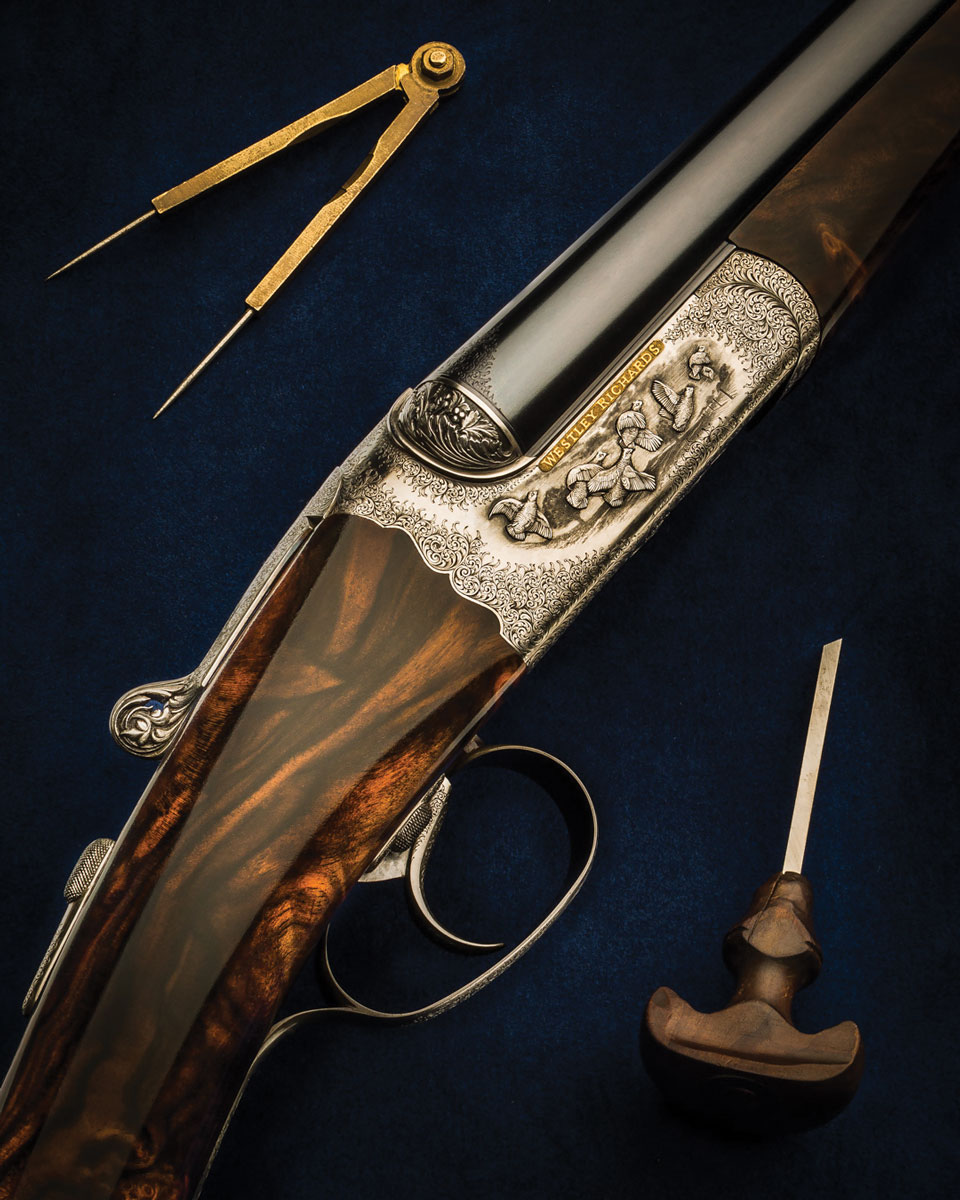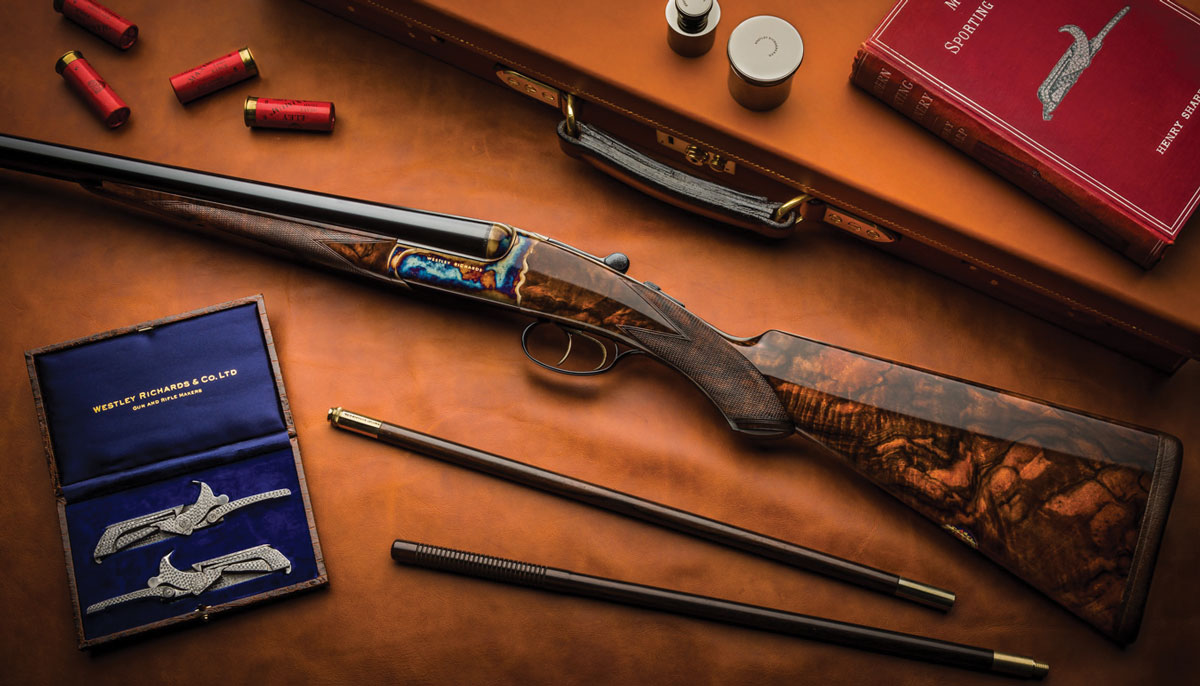The Westley Richards ‘droplock’: a stroke of gunmaking genius
At age 30, Sam Banner is already an old-school gunmaker; for 14 years he has built guns and rifles for Westley Richards. When I met him in the summer of 2018, he was at his bench, two stories above Pritchett Street in the heart of Birmingham’s old industrial quarter. With files and chisels and a smoke lamp, he was jointing one of the firm’s signature firearms: a Westley Richards hand-detachable-lock gun—better known in America as a “droplock.”
Jointing is the process that mates the bearing surfaces of a gun’s barrels to its action, and the skill with which it is done will determine the gun’s working life over time and use.
If the jointing is done poorly—so that the surfaces between barrels and action do not properly distribute and absorb stress when the gun is fired—the gun will shoot loose and develop what gunmakers call “the shakes.” In the case of a high-powered double rifle, these forces literally can tear the rifle apart.
Jointing a Westley Richards droplock, with its doll’s-head locking extension, requires extra-specialized skills and superb craftsmanship. There are more bearing surfaces to file and fit than on a conventional side-by-side gun, and they must join so finely that the action is not only durable, but also opens and closes smoothly. A former foreman at Westley Richards once told me that to joint the barrels to the action on a droplock takes some 55 hours, versus about 30 on a London sidelock.
Beside his bench, I watched Sam Banner painstakingly mate the barrels to their action, “smoking” the metal surfaces with soot and then pushing a file over them—two or three light strokes at a time—to remove high spots, some no larger than grains of sand. Then he repeated the process. And again, and again.
Today in the factory there are 14 craftsmen, mostly young men—actioners, stockers, checkerers, engravers and finishers—all masters of their craft, who make the 30 or so guns and rifles Westley Richards builds each year. More than two-thirds of the guns are droplocks, and upward of 600 hours of skilled handwork may go into each. That’s before engraving.
Every Westley Richards droplock is made entirely to order for the individual who commissioned it; there are no new “inventory” guns for sale here. As Managing Director Anthony Alborough-Tregear put it: “It ain’t bespoke if it’s off the bloody shelf!”
Once you place your order, you have to wait more than three years to receive your gun. “Do you want it fast,” Alborough-Tregear said, “or do you want it perfect?”
It’s not a choice. You will get it perfect. A droplock warrants perfection.
GENESIS
The droplock action was invented here—patented in 1897 by Leslie Taylor and John Deeley. This was 22 years after Westley Richards had revolutionized sporting-gun design with its Anson & Deeley (A&D) “boxlock” action, which used hammers hidden in an action “box” and cocked by the fall of the barrels as the gun was opened.

The droplock may have been an accidental breakthrough. According to company lore, Taylor asked the foreman if he somehow could hide the heads of the lock pins that pierced the sides of the action body—protrusions that Taylor thought ugly. The foreman’s solution was ingenious: Essentially, he turned the sidelock concept outside-in. Instead of mounting the lockwork onto sideplates, Deeley and his team attached the A&D’s simple lockwork—hammer, mainspring, sear, sear spring, cocking dog—to two small vertical plates that were then inserted through the bottom of the action body. Fastened to the plates as they were, the locks didn’t need supporting pins across the width of the action or holes to support the pins. Furthermore, if they could be slid into place from below, the locks could be dropped out again, too, for repair or replacement.
The advantages of a removable cover plate and hand-detachable locks soon became apparent and were spelled out in the 1897 patent. Over the next decade Westley’s refined this design, pairing it with the firm’s other significant inventions, including the Deeley & Edge forend latch of 1873, the Deeley ejector of 1884 and the 1901 single selective “One” Trigger. In 1908 Taylor patented a cover plate that was hinged to the action, to prevent losing it, and a year later he patented an improved “One” Trigger. The perfected droplock, as we now know it and as it still is built today, had arrived.
DESIGNED PERFECTION
Whether by accident or intent, the droplock was—like Westley’s original A&D boxlock—a stroke of gunmaking genius. In their heyday, in the late 19th Century, Britain’s gunmakers developed a wealth of great sporting arms, the best of which still are made today; but as a single design that can serve both guns and rifles, the Westley Richards droplock has proven itself perhaps the most versatile and adaptable of them all. By now thousands of droplocks have been made—from petite .410 shotguns to massive double rifles in .700/.577 Nitro Express and in every bore and caliber in between.

As a mechanism for hard work, the droplock has four principal virtues: It is simple, it is reliable, it is strong and it is easily cleaned and serviced. Each detachable lock has only five working components, compared to eight or more for a typical sidelock. All of its parts are robust too; unlike a sidelock, there are no small springs or delicate swivels. As Henry Sharp wrote of the droplock in Modern Sporting Gunnery in 1906: “There is not one part too few, nor one part too many.”
The droplock gun’s bolting is immensely strong. In 1862 Westley Richards patented its doll’s-head extension, the first effective top fastener, and then perfected it with the type “C” variant, still used today. A doll’s-head locks the barrels to the top of the action as far as possible from the hinge pin. Properly fitted, this significantly minimizes flex in the action bar when the gun is fired and greatly reduces stress at that critical angle between the breech face and the action flats.
The action table on a conventional boxlock is relatively thin compared to that of, say, a back-action sidelock. Moreover, the pin upon which its hammers pivot is directly beneath the nearly right angle where flex is concentrated, and critics of the traditional A&D like to point out that the hole for this pin inevitably removes metal from the frame where it is most needed. The global success of the A&D action over an incredible 145 years indicates that this potential weakness is more theoretical than real, especially in properly made boxlock shotguns. Double rifles built on conventional A&D actions invariably have a top extension to add strength—a Westley Richards doll’s-head or variant like the old Webley Screw Grip or a Greener crossbolt. A droplock, however, has no holes through its action, and when its broad, pinless frame is subsequently coupled with a doll’s-head fastener, the result is a gun or rifle of extraordinary strength.
Dangerous-game rifles—a Westley Richards specialty—are the acid test of a gunmaker; failure can mean injury or death to the shooter. “Our double rifles get used,” Alborough-Tregear said. “They have to work—and work all the time, every time.”

In the bush, the droplock’s sealed action protects the lockwork, but if cleaning becomes necessary, removing the locks is as easy as pressing a button to open the cover plate and taking them out with thumb and forefinger. Alborough-Tregear recalls a client who dunked his droplock into a river while hunting in Africa: “He pulled the locks, dried and oiled them, and was back in business.” And in the extremely unlikely case of a lock going wrong, a replacement can be dropped straight in—assuming you’ve got a set of spares.
For geeky gun cranks—“mechanicians,” as Henry Sharp called us—popping out the jeweled locks for a look is an incredible tactile and visual treat and, unless we accidentally drop and damage them, it is not possible to do any harm. By design, they cannot be put in backward and, unlike those sidelocks with detachable lockplates, there is no surrounding wood for ham-fisted amateurs to mark.
THE MODERN DROPLOCK
Today’s Westley Richards droplock is almost unaltered from the design perfected in 1909, but there have been some minor changes. Nowadays Westley Richards makes its actions a bit wider than before; this adds some strength but, more importantly, the extra width allows hand-filing of the action to a rounder, more attractive curve, particularly at the bottom corners. A not-so-minor change comes with 21st Century metallurgy; modern metal is much better than Victorian steel and makes a strong design stronger yet.
To really understand why new Westley Richards droplocks are so special, we must also consider proportion and scale. Achieving perfection in both has been an obsession of the company’s. The two attributes are closely related but not quite the same. Perfect proportions add beauty—to the figure of a woman, to the action and stock of a gun, to virtually everything. Proper scale, on the other hand, not only helps deliver guns with weight and balance appropriate to their bore, but also can be critical to mechanical reliability.
Smallbore droplock shotguns are especially popular these days, and small guns are harder to build and make reliable. As size decreases, hammers become lighter, springs become more stressed and the geometry of cocking and ejecting mechanisms changes subtly. Smaller components are more difficult to machine and to work with. Today, every Westley Richards droplock is built on a scaled frame—properly sized—to its bore or caliber, from .410 to 4 bore.

Since the late 1980s, when the droplock was put back into regular production, Westley Richards has made full use of its in-house engineering and tool-making division, employing computerized design programs to correctly scale each component and action, and then using its computer-controlled millers, spark eroders and wire cutters to create the parts with which craftsmen build guns and rifles.
In 2016 David Brown, who lives by the Red River in North Texas, received the new .410 droplock he’d ordered from Westley Richards 2½ years earlier—delivered just as promised at 5 pounds 5 ounces and with 28-inch Teague-choked barrels and game-scene engraving inspired by William Harnden Foster. Brown is an expert on British guns, a collector and a serious shooter. “Somewhere north of 5,000 rounds so far and zero malfunctions,” Brown reported after the first season with his little .410. “Never has the gun failed to go bang or eject, and the triggers are as crisp as on day one. Quite frankly, the gun is a joy to shoot, and when I do my part, the doves are in trouble.”
On the other end of the gunmaking scale, Alborough-Tregear told me of a client in Africa, a hunter armed with a .500 droplock double rifle. After killing a charging buffalo at very close range, he rang Alborough-Tregear to blurt out, “Long live Westley Richards!”
Long live the droplock. 
This article originally appeared in the first printed edition of The Explora journal and is reprinted courtesy of Westley Richards. For more information, visit westleyrichards.com. Photographs courtesy of Westley Richards.





